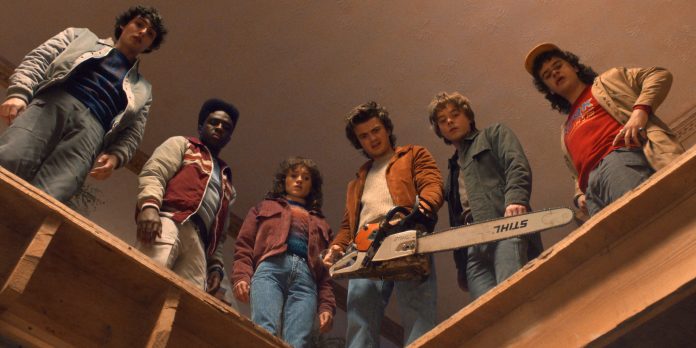THE STORY – In 1980s Indiana, a group of young friends witness supernatural forces and secret government exploits. As they search for answers, the children unravel a series of extraordinary mysteries.
THE CAST – Winona Ryder, David Harbour, Finn Wolfhard, Millie Bobby Brown, Gaten Matarazzo, Caleb McLaughlin, Natalia Dyer, Charlie Heaton, Cara Buono, Noah Schnapp, Sadie Sink, Joe Keery, Maya Hawke, Linda Hamilton, Priah Ferguson & Jamie Campbell Bower
THE TEAM – The Duffer Brothers (Showrunners/Writer/Director)
It has become increasingly difficult to remember what made audiences fall in love with “Stranger Things” in the first place when watching the first batch of episodes from the final series. The viewing experience often feels like the obligation to complete a long commitment rather than the gratification of witnessing something genuinely exciting on screen. When the series debuted in 2016, its synth score by Kyle Dixon and Michael Stein instantly embedded itself in the cultural consciousness. It was easy to see why viewers fell head over heels for the show. With time, however, the memory of The Duffer Brothers delivering one of the most confident debut seasons in recent television history grows faint. That first season blended Stephen King influences with Spielberg-like charm, establishing a tone and identity that shaped the show’s DNA. Yet much of that early magic seems absent now. Whether it is the cast aging out of believability or the sense that some performers no longer appear fully engaged, something feels off. With half of the final season now available, the outlook for the beloved Hawkins ensemble is not particularly encouraging.
This shift did not occur overnight. Although the series has maintained moments of brilliance, its quality has fluctuated over the years. Viewers often forgave its missteps because the highs were so strong. Unfortunately, the final season is the first to suggest that the series should have ended in the previous decade. After a three-year gap since season four, momentum has all but evaporated. The Duffer Brothers once adhered to traditional television rhythms but have shifted toward event-sized episodes that run as long as feature films. Instead of building anticipation, the lengthy breaks have eroded audiences’ memories of earlier seasons. For those in need of the automated Netflix recap, season four concluded with Hawkins witnessing the Upside Down beginning to merge with the real world.
Eighteen months later, the town is under a military-mandated quarantine, a status that essentially neutralizes the dramatic cliffhanger that ended season four. Season five opens in familiar fashion, reintroducing the characters as “Kids” plays. The show briefly recaptures its old rhythm, even if it leads to some of the most unnecessary storylines in the series, such as a romantic competition involving Jonathan and Steve vying for Nancy’s attention. Eleven is training more intensely than ever, Robin broadcasts coded signals across the radio airwaves, and Dustin attempts to cope with Eddie Munson’s death by mirroring his late friend’s aesthetic. These plotlines set the stage for the group’s mission to track down Vecna, who vanished into the Upside Down after season four. Their coordinated “crawls” require multiple subgroups to execute. As expected, things go wrong, danger escalates, and the ensemble confronts both familiar and new horrors.
For the first time, the season offers no overarching mystery. All information is presented upfront, sometimes excessively so, as characters verbalize every emotional beat. The series appears to be regressing in several areas. Performances are less consistent, with the once-remarkable child actors now seeming mismatched with the material. The growing ensemble leaves little room for individual character development, and the strategic arrangement of groupings feels more calculated than organic. The constant repositioning of storylines has become increasingly visible, weakening relationships that once felt natural. Even the pairing of Robin and Will, central to the season’s mid-point developments, follows predictable patterns.
Despite these issues, the season is not without merit. A well-staged set piece at the end of episode three, directed by Frank Darabont, stands out, and the ensemble’s innate charm surfaces occasionally, albeit faintly. The stakes feel diminished, the writing has slipped, and emotional investment appears to be at an all-time low. The magic that defined “Stranger Things” seems past its expiration date. The season’s big emotional moment fails to generate the impact the series clearly intends, and the release strategy, splitting the season into three separate releases (and all on national holidays, nevertheless), disrupts pacing rather than enhances it, seemingly designed to keep the show trending through the holiday season.
When “Stranger Things” first premiered, it captivated global audiences and sparked a surge of ’80s nostalgia across Hollywood. Nearly a decade later, that era feels distant. There is still time for the series to course-correct, especially given that the remaining episodes total more screen time than the entire first season. Whether the creators can land the plane remains uncertain, but it is difficult to argue that concern is unwarranted.
 THE GOOD – Netflix’s most popular still has some fun left in its tank, as The Duffer Brothers are able to create an engaging series when they’re firing on all cylinders.
THE GOOD – Netflix’s most popular still has some fun left in its tank, as The Duffer Brothers are able to create an engaging series when they’re firing on all cylinders.
THE BAD – It seems everyone is ready to move on as the magic that made the series so special is slowly draining as this approaches the final stretch. The big moments that would’ve wowed audiences years ago are emptier due to inconsistent performances and weak storytelling.
THE EMMY PROSPECTS – None
THE FINAL SCORE – 5/10


